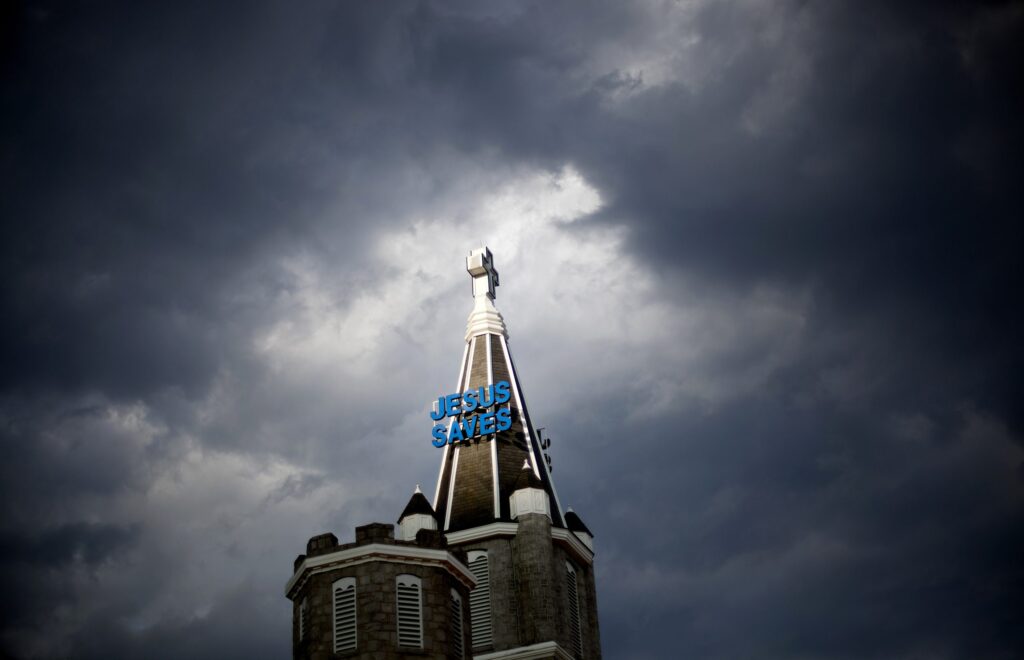If you have ever driven along the Interstate 75/85 interchange in downtown Atlanta, amongst the skyline, you have likely seen a tall gray structure with a blue illuminated sign that reads “Jesus Saves.”
The iconic yet simple message is a foundational doctrine to the building’s occupants, the congregation of Big Bethel African Methodist Episcopal Church, one of the largest and oldest Black churches located in Atlanta’s historic Sweet Auburn neighborhood, according to its current pastor, John Foster.
“We just praise God,” Foster said with a light smile. “This building is 100 years old. Big Bethel has grown over these 176 years, and being in any old structure, it has a wear and tear as the years go on.”
Now, the church is getting some major help in preserving its aging structure — a 1920s era Romanesque style brick building that replaced an earlier Victorian sanctuary destroyed by fire — in the form of a $200,000 grant from the National Trust for Historic Preservation’s African American Culture Heritage Action Fund. The grant’s purpose is to assist with capital projects that preserve the history tied to the nation’s Black churches. And in Big Bethel, there’s lots worth preserving.
If the nearby Ebenezer Baptist Church, whose pulpit incubated the theology of the Rev. Martin Luther King Jr., is Atlanta’s most famous house of worship, Big Bethel could lay a claim to rivaling Ebenezer’s historic and cultural significance.
Big Bethel’s 176-year history can be traced back to its original congregation of enslaved people who were allowed worship time by white masters of the Methodist Episicopal Church at the original church site at Courtland and Jenkins streets in downtown Atlanta.
The church has also played a vital role in Atlanta’s black political, education and cultural history, dating back as far as 1881 when its hosting of the North Georgia Annual Conference led to the founding of Morris Brown College. The first national convention of the NAACP was held at Big Bethel in 1920.
During the Civil Rights Movement of the 1950s and ’60s, Bethel’s halls served as the location of planning committees, and marches often passed right by their doorsteps, Foster said.
“There were really four major civil rights churches on Auburn,” Foster recounted. “Between those four churches — Wheat Street, us (Big Bethel), Ebenezer and Butler Street — the Black civil rights community in Atlanta held all of its strategy meetings.”
Preserving that history is a mission that Nichole Phillips, professor of religion and director of the Black Church Studies Program at Emory University’s Candler School of Theology, says is critical to the archival history of the community.
“Preservation is important to the story of Black America and the beginnings of Black America,” she said, noting that the institution of the Black church and gathering in religious spirit predates the actual Black community itself. “When you get a $200,000 grant, it makes a statement about the materials [and] archives, but it also makes a statement about the institution.”
Thirty-one churches nationwide were selected to receive more than $4 million from the fund, according to the fund’s executive director, Brent Leggs. He says that the preservation work that the fund now supports has been cultivated by Black Americans informally for generations, even before it was recognized as such.
“We did not have the lexicon or the language to describe ourselves as preservationists at that time,” Leggs told Capital B ATL. “However, Black church congregations were investing in the cyclical maintenance of historic Black churches, or family members gathered together at the family cemetery to cut the grass. That is an informal kind of preservation.”
Through the formalization of conservation processes, Leggs says, the main goal of the fund’s Preserving Black Churches initiative is to deploy and reimagine practices by supporting black churches with asset management, interpretation and architectural planning that will support the long term stewardship of their cultural assets.
Foster says the money will help Big Bethel address structural issues within the church’s main sanctuary. This will include replacing degraded mortar and joints, rehinging and replacing old doors, replacing the sanctuary’s stained-glass windows, and making the facility watertight so it can last for at least 40 more years.
The funds, he said, will be an addition to aiding the church’s ability to continue their work in the greater Black Atlanta community, a doctrine he calls “work beyond Sunday morning.”
“If a Black church fails, then our community suffers, so we thank God for the success,” Foster said.
Correction: Brent Leggs is the executive director of the African American Cultural Heritage Action Fund. He was misidentified in an earlier version of this story.
Read More



